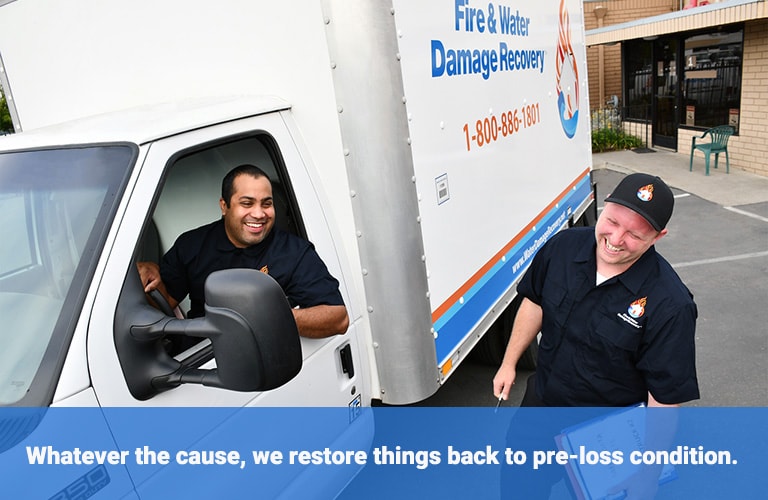The Best Guide To Dry Star Restoration
The Best Guide To Dry Star Restoration
Blog Article
What Does Dry Star Restoration Do?
Table of ContentsA Biased View of Dry Star RestorationDry Star Restoration - TruthsThe Facts About Dry Star Restoration UncoveredDry Star Restoration - QuestionsAn Unbiased View of Dry Star Restoration
Within mins, the kitchen was ablaze, causing substantial damages and calling for months of remediation work. Particularly in winter months, home heating systems are a typical fire danger. Damaged circuitry or placing heating units too near flammable products like curtains can spark a fire. Constantly maintain heating units far from anything that can burn and inspect them on a regular basis.
Products like motor oil or cleaning liquids can spark under details problems. Constantly store these things appropriately and far from heat resources. emergency water damage cleanup. Stats: According to the National Fire Protection Organization, household chemicals are in charge of a noteworthy portion of home fires every year. By understanding these common causes, you can take steps to make your home safer.
Examine This Report on Dry Star Restoration

Trick problems consist of: Water Invasion: Water can permeate into walls, floors, and furniture. This can damage the structural honesty of your home. Build Growth: If water is not dried swiftly, mold can start to expand within 24-48 hours. Mold and mildew can trigger wellness problems and further damages to your property. Structural Weakening: Water can damage wood frameworks and cause metal components to rust, making your home dangerous.
Next, we will dive into the actions entailed in the fire damage remediation procedure. Fire reconstruction is the process of cleaning, repairing, and recovering a building that has been damaged by fire.
3 Simple Techniques For Dry Star Restoration
Debris Elimination and Demolition: Harmed products are safely removed, and any hazardous substances like asbestos are taken care of suitably. Cleansing and Decontamination: Soot and smoke odors are removed using customized devices and treatments. Repair and Fixes: Lastly, the building is restored and brought back, including architectural repair work and indoor repair - fire damage restoration companies. Fire damages includes numerous kinds of injury to a residential property: Physical Damages: This includes charring, blackening, and disintegration of materials straight influenced by the fire.
Water Damages: Water utilized to extinguish the fire can cause architectural weakening and mold and mildew growth if not properly taken care of. Fire reconstruction professionals utilize specialized strategies and equipment to attend to all these kinds of damage, making sure the home is safe and livable once more. Next off, we will certainly dive into the steps included in the fire damages reconstruction process.
From state-of-the-art water check this site out removal equipment to specialized tools for smoke and residue elimination, we have actually the sources required to recover your residential or commercial property to its pre-loss condition. Our methods are made to be thorough and efficient, lessening more damages and quickening the recovery process. Our team consists of certified specialists who are professionals in fire damages repair.
Rumored Buzz on Dry Star Restoration
Their expertise makes sure that every work is done right, offering you with tranquility of mind throughout a tough time. We're here to aid you restore your home and your life after the fire.
(https://anotepad.com/notes/t8q4circ)If there's a fire, smoke is certain to follow. While the fire's smoke is composed of elements that make your home hazardous to be in, the damage smoke leaves behind doesn't stop there. Smoke will float to seemingly every part of your home, sticking to furniture, decor, drapes, wall surfaces, ceilings, floors, and more.
The water will certainly soak into the charred materials and infected various other locations of the home unaffected by the fire. If left unattended or missed during fire damages repair, the water damages will only worsen with time and can lead to mold and mildew development, security issues for your home's structure, and undesirable looks around your space, including deformed floor covering, peeling paint, and noticeable stains.
Dry Star Restoration - An Overview
Water reduction is often the first step of the fire, smoke, and water damage repair procedure after a damage control has actually been completed. This addresses the water damages head-on and consists of steps to avoid further troubles for your area before, during, and after repair. Assessment and damage control to analyze the degree of water damageIsolation of water damages to impacted locations to forbid water from infecting dry areasInspection of your home's foundation for architectural stabilityExtraction of any type of standing water from the propertyStructural drying with commercial-grade equipmentSite cleanup that will remove particles, pack out salvageable content for reconstruction, and give way for restoration servicesWe'll additionally complete extra damages mitigation by boarding up broken doors and windows, applying tarps to openings in roof coverings, and completing other actions to stop additional damage and dangers to your home while the repairs are happening.
A lot of terms and summaries used by water and fire damage reconstruction contractors are relatively self-explanatory. The checklist of terms below ought to be of aid when you're communicating with the business you've worked with. Any kind of action required to prevent the growth and dispersing of fungus, mold and mildew, mildew, and spores. This can consist of using solvents or chemicals as additives or obstacles on structure products to avoid fungi growth.
Report this page